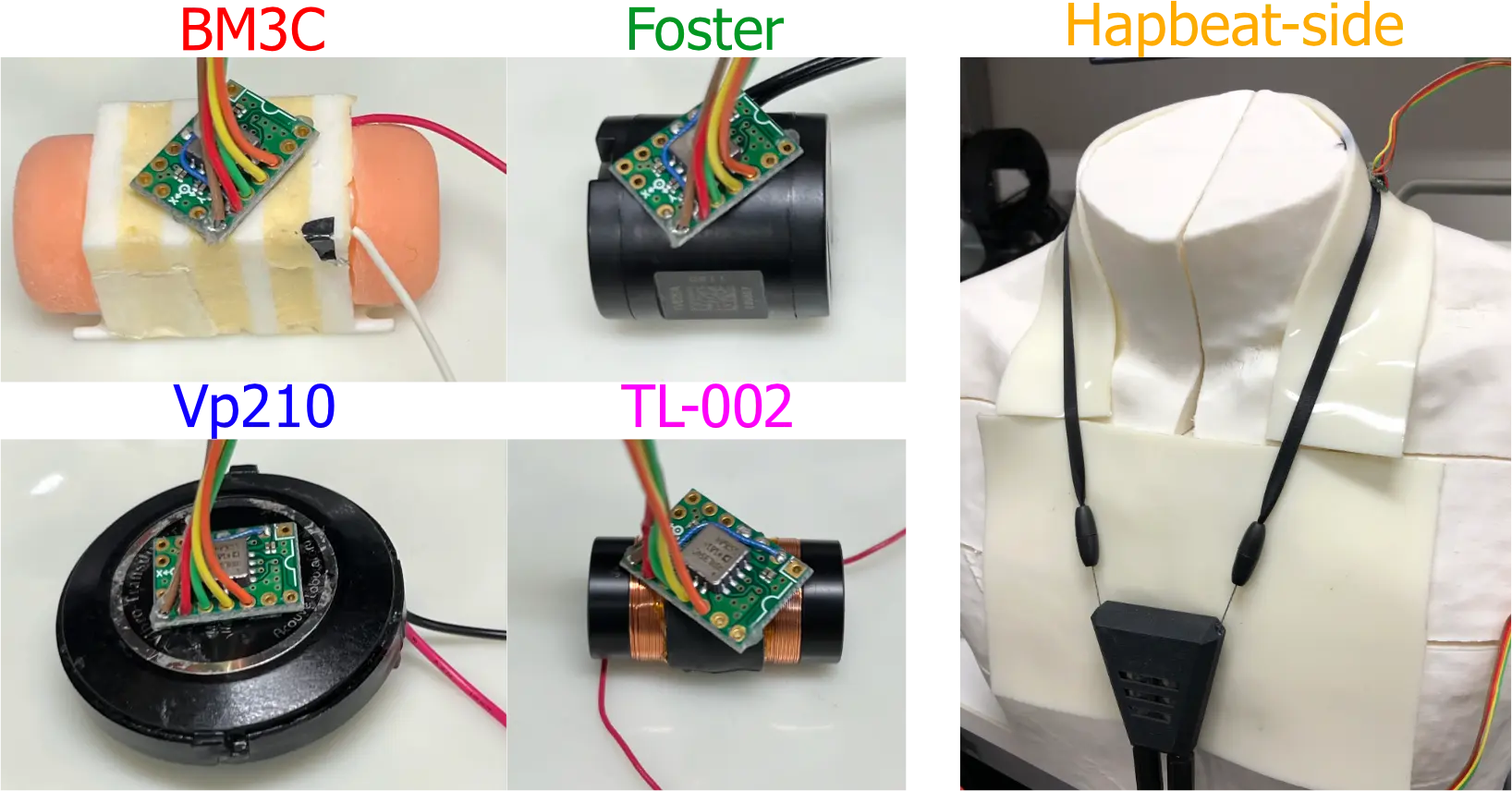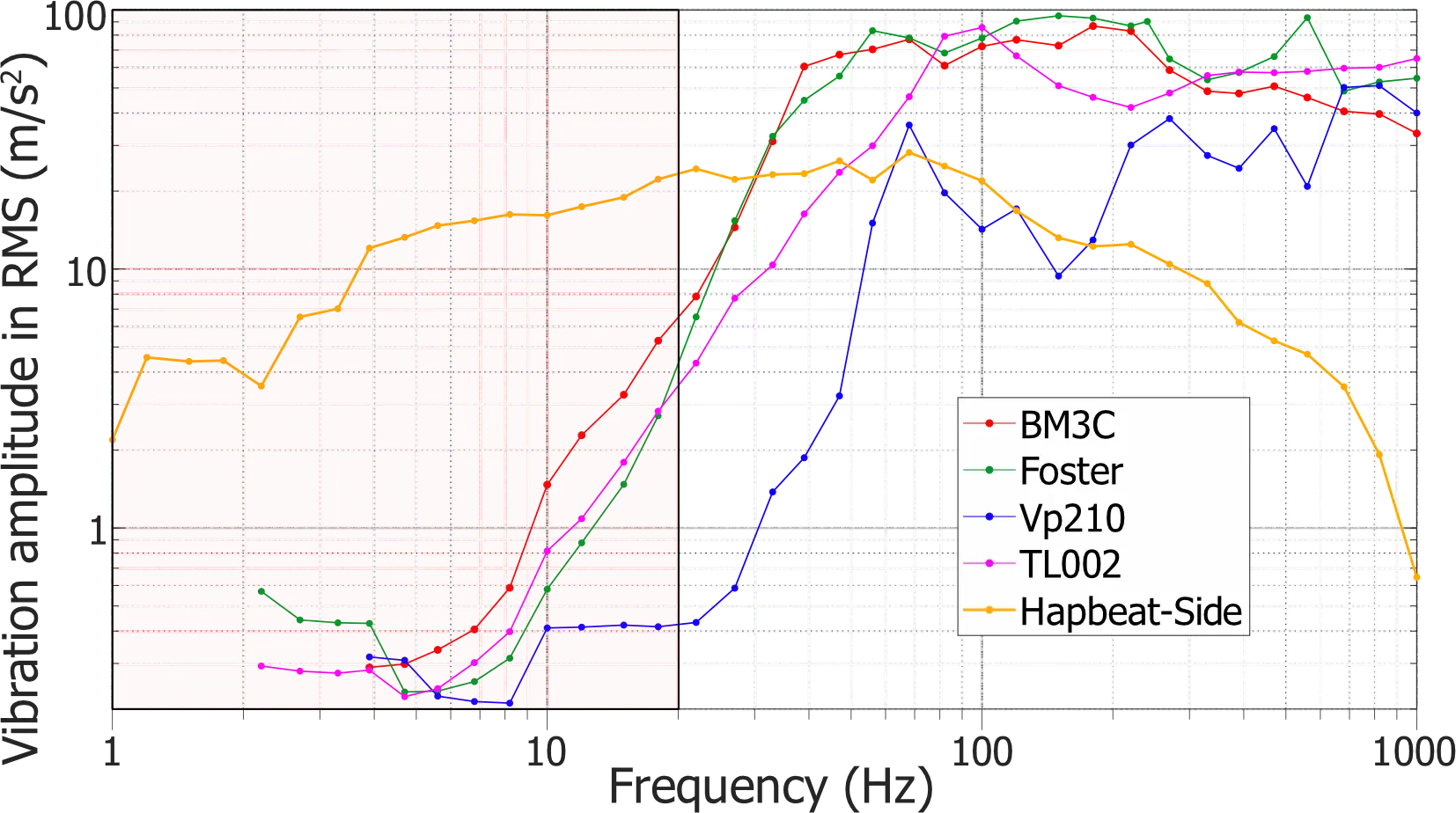Technical Overview: Tension-based Vibration Generation Mechanism
The tension-based vibration generation mechanism invented at Tokyo Institute of Technology makes it possible to transmit compact and powerful low-frequency vibrations over a wide body area, which was difficult to achieve with conventional vibration generation mechanisms.
How Vibration is Transmitted to the Body
Tension-based vibration generation mechanism
The DC motor shaft rotates forward and backward in response to the input signal, such as a sound wave (change in voltage), causing the threads fixed to the bobbin to move in parallel. The threads are rolled out of the enclosure and contact the wearer's body, deforming the skin in response to the rotation of the motor shaft, thereby outputting vibrations to the wearer. The key point is that the rotational motion is converted into parallel motion. A comparison with conventional transducers is shown at the bottom of this page.
Working Example
Hapbeat vs. loud speaker
Music signal input: Hapbeat vibration output comparison
Sine wave input (10~1000 Hz): Comparison of Hapbeat vibration output
Hapbeat vs. loud speaker
Vibration Transmission to the Body

Measurement of transmitted vibration of Hapbeat (principle prototype) and Haptuator
This experiment compares the degree to which Hapbeat transmits vibrations to the body with the Haptuator (representative of conventional transducers). The squares in the figure represent the amplitude of the transmitted vibration. The figure shows that Hapbeat transmits vibrations more widely and evenly than the Haptuator, which transmits large vibrations even at 30 Hz.

Measurement of the transmitted vibration by a necklace-type Hapbeat
This results from measuring the vibration transmitted to the body when the necklace-type Hapbeat is worn with clothes on. The size of the red circle indicates the amplitude of the transmitted vibration. The figure shows that vibrations are transmitted from the band over a wide area.
Problems with Conventional Vibration Generation Mechanisms
Conventional Vibration Generation Mechanism (Linear Vibrator)
Conventional vibration generators generate vibration by the reaction force of moving weight. Therefore, the vibration amplitude depends on the weight's mass and the movable distance. This is particularly important for low-frequency vibrations, and small transducers cannot, in principle, produce large vibrations because their movable distance is short.
(This is a principle similar to a small speaker's inability to produce enough bass as a subwoofer.)
Vibration Measurement Results

Measurement conditions: 20 Hz sine wave, power consumption 1 W

Measurement Results
The measurement results show that the linear vibrators cannot output sufficient vibration compared to Hapbeat in a bandwidth lower than 20 Hz.
Enhancing Music-listening Experience and Haptic Navigation Simultaneously
We proposed an application of Hapbeat haptic navigation. Novelty is it can express the direction, distance, and height of a destination or target while enjoying the vibrations of the music, taking full advantage of Hapbeat's compatibility with music. Please take a look at the video below.
Navigation to the destination while enjoying music (direction and distance)
Guiding target's location in a VR shooting game (direction and height)
特許
Vibration presentation apparatus and method for using the same [JP] [US]
Academic Publications
Dissertation
Tension-type vibration presentation device that enriches an individual's virtual soundscape with experiential acoustics (Tokyo Institute of Technology, March 2023)
Journal papers
1. Yusuke Yamazaki and S. Hasegawa, “Navigation Method Enhancing Music Listening Experience by Stimulating Both Neck Sides With Modulated Musical Vibration,” in IEEE Transactions on Haptics, doi: 10.1109/TOH.2023.3266194.
2. Y. Yamazaki, H. Mitake and S. Hasegawa, “Implementation of Tension-Based CompactNecklace-Type Haptic Device Achieving Widespread Transmission of Low-Frequency Vibra-tions,” in IEEE Transactions on Haptics, vol. 15, no. 3, pp. 535-546, 1 July-Sept. 2022, doi: 10.1109/TOH.2022.3176673.
Conference papers
1. Yusuke Yamazaki and Shoichi Hasegawa. “Providing 3D Guidance and Improving the Music-Listening Experience in Virtual Reality Shooting Games Using Musical Vibrotactile Feedback,”IEEE VR 2023, the 30th IEEE Conference on Virtual Reality and 3D User Interfaces, 2023.
2. Yamazaki, Y., Mitake, H., Hasegawa, S. (2016). Tension-Based Wearable Vibroacoustic Device forMusic Appreciation. In: Bello, F., Kajimoto, H., Visell, Y. (eds) Haptics: Perception, Devices,Control, and Applications. EuroHaptics 2016. Lecture Notes in Computer Science(), vol 9775.Springer, Cham. https://doi.org/10.1007/978-3-319-42324-1 27
Conference demos and posters
1. Yusuke Yamazaki, Shoichi Hasegawa, Hironori Mitake, and Akihiko Shirai. 2019. Neck straphaptics: an algorithm for non-visible VR information using haptic perception on the neck. InACM SIGGRAPH 2019 Posters (SIGGRAPH ’19). Association for Computing Machinery, NewYork, NY, USA, Article 60, 1 – 2. https://doi.org/10.1145/3306214.33385628-3-319-42324-1 27
2. Yusuke Yamazaki, Hironori Mitake, Ryuto Oda, Hsueh-Han Wu, Shoichi Hasegawa, Mi-natsu Takekoshi, Yuji Tsukamoto, and Testuaki Baba. 2017. Hapbeat: single DOF widerange wearable haptic display. In ACM SIGGRAPH 2017 Emerging Technologies (SIG-GRAPH ’17). Association for Computing Machinery, New York, NY, USA, Article 12, 1 – 2.https://doi.org/10.1145/3084822.3084843
3. Yamazaki, Y., Mitake, H., Takekoshi, M., Tsukamoto, Y., Baba, T., Hasegawa, S. (2018). Hapbeat: Tension-Based Wearable Vibroacoustic Device. In: Hasegawa, S., Konyo, M., Kyung, KU.,Nojima, T., Kajimoto, H. (eds) Haptic Interaction. AsiaHaptics 2016. Lecture Notes in ElectricalEngineering, vol 432. Springer, Singapore. https://doi.org/10.1007/978-981-10-4157-0 65
Conferences in Japan
1. 山崎勇祐, 長谷川晶一. “首両側面への音楽振動提示による音楽鑑賞体験の向上を伴うナビゲーション手法の提案.” 日本バーチャルリアリティ学会大会論文集 (CD-ROM) 27th (2022): ROM-BUNNO.11C – 2.
2. 山崎勇祐, et al. “Hapbeat: 張力に基づいた装着型体感音響装置.” インタラクション 2017 論文集 3-409 – 72 (2017): 918 – 920.
3. 山崎勇祐, 長谷川晶一. “装着型振動提示装置の提案.” 日本バーチャルリアリティ学会大会論文集 (CD-ROM) 20th (2015): ROMBUNNO.11C – 2.
Invited Speeches
1. Yamazaki, Y., Mitake, H., Akihiko, S., & Hasegawa, S. (2019). Widespread the hapbeat: Tensionbased necklace type haptic display. In 26th International Display Workshops, IDW 2019 (pp.1656-1659). (Proceedings of the International Display Workshops; Vol. 3). International DisplayWorkshops.
©2025 Hapbeat LLC
Privacy Policy